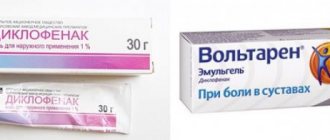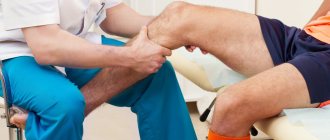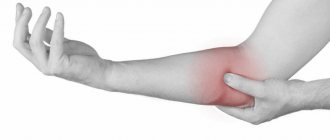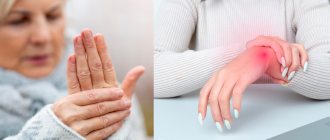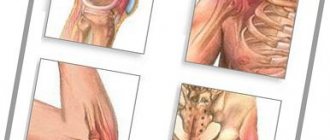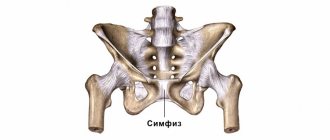Pain in the joints of the arms and legs can be of a very diverse nature, just as the causes of its occurrence differ. The appearance of pain in the joints of the hands can be caused by inflammatory processes or degenerative changes in the joints themselves or the tissues surrounding them. Pain can be felt in the elbow or wrist joints of the hands, it can be muscular and neurogenic; it is better to entrust the determination of the cause of its occurrence and the choice of a means to reduce pain to a doctor without self-medication.
Why do my joints hurt?
Joints can hurt for two reasons: arthritis, inflammation of joint tissue, or arthrosis (osteoarthrosis), a degenerative-dystrophic process, that is, destruction of the osteochondral elements of the joint.
The diagnosis must be made by a doctor, but you can navigate the symptoms yourself. Inflammation in arthritis is like a forest fire: everything starts violently, the joint swells and hurts very much even at rest, and when you try to make the slightest movement, the pain intensifies. The skin in this area turns red and feels hot to the touch.
With arthrosis, everything is different: the joints are destroyed slowly and unnoticeably at first. Pain in the joints, at first slight, aching, occurring only with movement, is quite tolerable, but grows over time, becoming constant and strong enough to disturb rest and sleep. The insidiousness of this pain is that it is delayed in relation to the pathological process that occurs in the joint, and occurs only when signs of destruction of the corresponding joint, unfortunately irreversible, become visible on X-ray photographs. This is the growth of spines (marginal osteophytes) along the edge of the articular surfaces of the bones that form the joint, narrowing of the joint space and signs of osteosclerosis - areas of pathological increase in bone density (Fig. 1). If arthrosis affects one joint, say the knee, the biomechanics change and the function of neighboring joints - the hip and ankle - is disrupted. They experience increased and uneven load and, as a result, wear out faster. Thus, arthrosis affects joint after joint, and the pain intensifies and can spread to all new joints.
Figure 1. Arthrosis of the knee joint (gonarthrosis). The cartilage is destroyed, the joint space is narrowed, and there are growths on the bone - osteophytes, which impede movement. Source: CC0 Public Domain
Arthritis or arthrosis
For those who do not have a medical education or have not personally encountered problems with bones and joints, the two concepts: arthritis and arthrosis seem exactly the same. The similarity of the names is explained by the fact that all diseases associated with joints have the root “art”. The prefix “it” indicates an inflammatory process. This can be seen in the example of other terms: rhinitis - inflammation of the sinuses, bronchitis - inflammation of the bronchi; otitis – inflammation of the ear. However, the term does not indicate the causes of inflammation, which means it cannot be a diagnosis. Bronchitis, for example, can be both viral and bacterial. This means that treatment tactics in both cases are completely different. Arthritis is inflammation in a joint, without a description of the cause.
Arthrosis is a disease that affects the interarticular cartilage. Prolonged unexamined arthritis sooner or later leads to arthrosis. Inflammatory processes in the joint disrupt metabolism, due to which the tissues do not receive proper nutrition and become thinner. This is where the destruction of cartilage tissue occurs.
Types of pain
The type and nature of pain depends on the cause that caused it.
Joints ache with the flu and acute respiratory infections against a background of high (up to 40 ⁰C) temperature. This pain goes away on its own as soon as the temperature returns to normal and does not require special treatment.
Arthritis pain:
- spicy,
- painful,
- pulsating,
- shooting,
- occurs at rest and intensifies when performing certain movements,
- sending out to neighboring areas,
- when palpated, it hurts everywhere, over the entire surface of the joint, but especially along the joint space.
Periarthritis is especially unbearable - inflammation of the tissues around the joint (its bursa, tendons and ligaments). How everything happens can be explained using the example of the shoulder joint (Fig. 2). First the joint begins to ache. The pain very quickly becomes excruciating, almost unbearable. It radiates to the shoulder blade and neck area, intensifies (and is often accompanied by a crunching sound) when trying to stretch your arms to the sides at shoulder level or bend them at the elbow and place them behind your back. There are pain points at the end of the collarbone, which rests on the shoulder joint in front, and in the same place at the back. When you press on them with your finger, the pain intensifies. With such acute sensations, the joint requires immobilization - you need to hang your hand on a scarf, try not to move it. This is an important condition for the success of treatment.
Figure 2. Humeroscapular periarthritis. Inflammation of the soft tissue around the joint causes severe pain, often causing disability. The prevalence of the disease is high and amounts to about 4-7% in the population. Photo: CC0 Public Domain
Important! quickly select adequate pain relief and anti-inflammatory therapy after the examination. This will reduce the severity of joint inflammation, reduce pain and improve the quality of life.
With arthrosis, joint pain is different:
- At first, the pain is not severe and intermittent, its character is wave-like - at certain periods it does not exist for weeks or even months. But over time, without treatment, the waves of pain become more severe and come more often, and the intervals between them become shorter.
- Pain at the start: it explodes during the first attempt to take a step, raise an arm, or bend over. Then the joints seem to develop, and the pain goes away.
- Mechanical rhythm - the joint begins to hurt when you load it. First, the pain appears during high loads - lifting heavy objects, running up the stairs, long walking, playing sports. Later, even minor movements echo with pain. But at the same time, unlike the discomfort of arthritis, the pain of arthrosis goes away when you give the joint a rest and provide it with peace. That's why doctors talk about a mechanical rhythm: movement provokes pain, and rest relieves it.
- Night discomfort. There is no pain at rest as such, but lying down is uncomfortable, I always want to change my position, to find a position in which I could forget about the joints and spine, but I can’t. My joints ache, that's all!
- The shackles of the morning: you woke up, there is no pain yet, but it’s as if you were shackled with a chain or tightly swaddled - your joints don’t obey, but little by little the feeling of stiffness goes away, the range of motion in the joint is restored.
- Protective posture. When a joint hurts, you want to take the so-called antalgic - anti-pain pose, in which it becomes easier. This is best seen in the example of the spine: it also consists of joints. When one of them jams, and along with it a nerve root gets caught in a bone vice, acute pain occurs due to radiculitis. Anyone suffering from radiculitis can be diagnosed by anyone who sees how the poor thing is twisted. In fact, with the help of this “distortion”, supported by muscle spasm, the body tries to reduce pain to a minimum.
Arthrosis of the hip and knee
Pain when the hip joint is affected (and it most often affects one side) is localized in the upper part of the thigh and radiates to the knee. He usually starts getting sick in the afternoon, when he has already worked quite a lot. The pain intensifies when walking, and at rest weakens and disappears.
Most often, both knee joints are affected at once. They bend easily, but begin to hurt when bent. Damage to the knees is characterized by the so-called staircase symptom. It becomes more painful to go down than to go up; patients do this by turning sideways. Sometimes a joint becomes jammed in a half-bent position due to a bone outgrowth (osteophyte) or its fragment (such a bone fragment “lost” inside the joint is called an “articular mouse”). Blockage of the joint is accompanied by increased pain when trying to bend or straighten it.
Knee mobility problems are not always due to arthritis. Sometimes joint jamming can be “false”. Some of the most common causes of knee pseudolock include:
- Swelling (excess fluid in the joint capsule can prevent full flexion and extension of the joint),
- Inflammation (inflammation of tissue in the knee, such as in rheumatoid arthritis and gout),
- Incorrect movement of the kneecap in the joint (accompanied by severe pain),
- Irritation of the tissue lining the joint
- Knee injury (any serious injury to the knee, such as a sprain, can cause muscle spasm).
Important! If the joint is jammed and active movements in the joint are impossible, it is necessary to seek medical help as soon as possible from an orthopedic traumatologist - to an emergency room, hospital clinic. Do not hesitate to call an ambulance - this is a good reason to call it, because you won’t get far on one leg and you may not even get to the clinic yourself.
Symptoms of finger arthritis
The need for examination and possible treatment is indicated by such signs as swelling of the joints, pain (especially at night), and crunching. In the infectious and gouty form, general malaise and fever are likely.
Rheumatoid arthritis manifests itself as a spindle-shaped swelling and a “boutonniere” deformity. When the lower extremities are affected, the external manifestations are reduced to claw-shaped fingers or hammertoes.
Patients note the presence of morning stiffness in the form of a feeling of “tight gloves.” Due to poor circulation, the skin on the hands becomes dry and muscle atrophy is observed.
To develop adequate treatment for arthritis of the fingers, the kinesiotherapist takes into account its stage:
- in the first stage there is no pain, but in the morning the person experiences difficulty with tasks such as turning a tap or gas valve. However, the stiffness goes away quickly, so no one seeks treatment for arthritis at this stage;
- on the second, bone erosions appear, the fingers begin to ache, crackle, and swell. Unpleasant sensations accompany not only the morning, but also the afternoon;
- third stage - joint deformations occur. Fingers hurt, turn red, and become hot. Pain often appears in the morning;
- fourth - articular cartilage grows together, mobility is sharply limited. The person becomes helpless.
Diagnostics
Based on the nature of the pain and the appearance of the affected joint, even a non-specialist can make a preliminary diagnosis (arthritis or arthrosis). But hurry to your local clinic to confirm your assumptions!
A doctor examines a patient's sore knee. Photo: chayanuphol/freepik.com
Which doctor should I contact?
If you have joint pain, you should make an appointment with your local physician. He performs the functions of a medical dispatcher: he records complaints and clinical symptoms, refers the patient for examination and, based on its results, decides which doctor should be consulted for each specific patient. A variety of specialists are involved in maintaining joint health:
- arthrologist,
- traumatologist-orthopedist,
- rheumatologist,
- vertebrologist (if the spinal joints are affected),
- podiatrist (if we are talking about foot joints),
- surgeon,
- oncologist,
- neurologist (if the joint has already been treated, but the pain remains),
- nutritionist (if your joints hurt due to metabolic disorders, such as gout, or if you are overweight).
What tests and research should I do?
The examination begins with the simplest - a clinical (finger) and biochemical (from a vein) blood test for signs of inflammation, as well as a general urine test. In some joint diseases, the kidneys are involved in the pathological process. Excess uric acid salts in the urine may indicate gout as a cause of joint disease.
Laboratory examination of the synovial fluid located inside the joint helps to detect the inflammatory process and clarify its nature. It is obtained by puncturing the joint capsule - puncture. If necessary, a histological examination of a fragment of the synovial membrane lining the joint cavity from the inside is performed.
A proven diagnostic method is radiography of the joint in two standard projections. It will help visualize narrowing of the joint space, bone spurs, osteoporosis and osteosclerosis (areas of low and high bone density, Fig. 3).
Figure 3. X-ray of the right wrist. Development of osteoporosis (b, c) during treatment with human monoclonal antibodies. Arrows indicate two-layer sclerotic stripes after two courses of the drug. Source: Elsevier Ltd/The Lancet
Currently, magnetic resonance imaging provides comprehensive information about the condition of the joint.
What joint diseases can cause pain?
There are more than a hundred such diseases. In the elderly, arthrosis is widespread, and in the young, rheumatoid arthritis and injuries (bruises, fractures, ligament damage) are widespread.
“Together with arterial hypertension, which is commonly called hypertension, joint diseases lead the list of the most common reasons for seeking medical help. And the chronic pain that patients experience and because of which they cannot fully live and work is not only a medical, but also an important social problem,” says Doctor of Medical Sciences, Professor of the Department of Rheumatology of the Russian Medical Academy of Continuing Professional Education, senior lecturer educational department of the Research Institute of Rheumatology named after. V.A. Nasonova Natalya Vladimirovna Chichasova. – Of all joint diseases, arthrosis is the most common. 97% of those over 65 years old suffer from this disease. And if we talk about chronic inflammatory diseases of the joints - arthritis, rheumatoid arthritis comes to the fore. It is also not a gift, and not only because of the pain syndrome: already 3-5 years after its onset, this type of arthritis inevitably ends with the patient being assigned a disability group.”
Causes of finger arthritis
The disease is an inflammatory process affecting the metacarpophalangeal, metatarsophalangeal and interphalangeal joints of the upper and lower extremities. Most often, it is not an independent disease, but develops against the background of other pathologies (rheumatic, infectious, metabolic). Our center's kinestherapists provide effective treatment for finger arthritis.
The following causes of the disease are identified:
- age (the disease develops more often in older people);
- disruption of the endocrine glands;
- minor bone damage;
- infections (flu, ARVI);
- heredity;
- injuries, bruises, previous operations;
- bad habits (nicotine, alcohol);
- disorders in the vascular system (deterioration of joint nutrition);
- stress (stress hormones worsen the composition of joint lubrication).
How to get rid of joint pain urgently?
Pills.
Photo: Bloack / Depositphotos Analgesics can quickly overcome pain: you should not tolerate pain under any circumstances if you do not want it to turn from acute to chronic. This metamorphosis can happen very quickly - in 3-4 weeks, so getting rid of joint pain should be an immediate priority. The joint starts to hurt as soon as you put stress on it. Therefore, in case of pain, half an hour before any physical activity, you should take a non-steroidal anti-inflammatory drug (NSAID) with a good analgesic effect.
If joint pain intensifies at night, in addition, before going to bed, the doctor will recommend taking metamizole sodium, as well as drotaverine with nicotinic acid to improve local blood circulation.
Local therapy
NSAIDs have a dangerous side effect - they can cause damage to the gastric mucosa, even leading to the formation of ulcers, so they try to use them topically, as part of various ointments and gels with anti-inflammatory and analgesic properties. They are usually rubbed into the skin over the affected joint twice a day. Special patches with magnetic powder, which are glued to a joint or area of the spine, also relieve pain.
Cause of pain
Skeletal muscle pain is most often caused by direct trauma or injury from a muscle strain or tear. A muscle strain occurs when a few muscle fibers are damaged, while a muscle tear occurs when a large number of muscle fibers are torn. A rupture (tear) of a tendon can also lead to muscle pain. Muscles and tendons have the ability to regenerate, but if a muscle or tendon is severely ruptured, surgical restoration of the integrity of the damaged structures is required. Muscle pain can be caused by cramps resulting from overuse or abnormal nerve impulses that lead to excessive muscle contraction. In some cases, muscle pain can be a symptom of serious or life-threatening conditions such as a heart attack, meningitis, or cancer.
Traumatic causes of muscle pain
Muscle pain can be associated with any injury, including:
- Impact with a blunt object
- Muscle strain or tear
- Excessive or repetitive movements
- Nerve compression (due to disc herniation, spinal stenosis)
Neuromuscular diseases and conditions
- Amyotrophic lateral sclerosis (ALS, Charcot disease) is a severe neuromuscular disease that causes muscle weakness and disability.
- Brain or spinal cord injury
- Dermatomyositis (a condition characterized by muscle inflammation and skin rash)
- Lyme disease (an inflammatory bacterial disease transmitted by ticks)
- Multiple sclerosis (a disease that affects the brain and spinal cord and causes weakness, coordination, balance, and other problems)
- Muscle breakdown (rhabdomyolysis)
- Muscle infections such as an abscess
- Parkinson's disease (a brain disease that causes poor movement and coordination)
- Polymyalgia rheumatica (a condition characterized by muscle pain and stiffness)
- Polymyositis (muscle inflammation and weakness)
- Stroke
Other possible causes of muscle pain
Muscle pain can be caused by many other diseases and conditions, including:
- Cancer
- Depression
- Fibromyalgia
- Angina or myocardial infarction
- Hypothyroidism
- Flu or other respiratory illnesses
- Kidney failure
- Electrolyte disturbances (abnormalities in potassium or calcium levels in the blood).
- Pregnancy
- Systemic lupus erythematosus
- Vitamin B12 or vitamin D deficiency
Medicines and substances that can cause muscle pain include:
- ACE inhibitors (used to lower blood pressure)
- Cocaine
- Statins (cholesterol-lowering drugs)
Questions that help determine the cause of muscle pain include:
- Are there other symptoms such as sore throat or fever?
- Do you feel pain in one specific area or throughout your body?
- How long does this condition last?
- In what parts of the body is pain localized?
- What reduces pain or increases pain?
- What medications are you currently taking or have recently taken?
Potential complications of muscle pain
Complications associated with muscle pain depend on the underlying disease or condition. For example, muscle pain associated with fibromyalgia or a degenerative disease can lead to decreased mobility and associated complications. Many skeletal muscle pains, however, respond well to treatment. However, if muscle pain is prolonged and associated with a systemic disease, it can lead to the following complications, including:
- Chronic pain
- Immobility and associated complications (such as bedsores and blood clots)
- Persistent pain resistant to treatment
- Amyotrophy
- Muscle contracture
- Permanent muscle or nerve damage (most often due to nerve compression), including paralysis.
- Decreased quality of life
